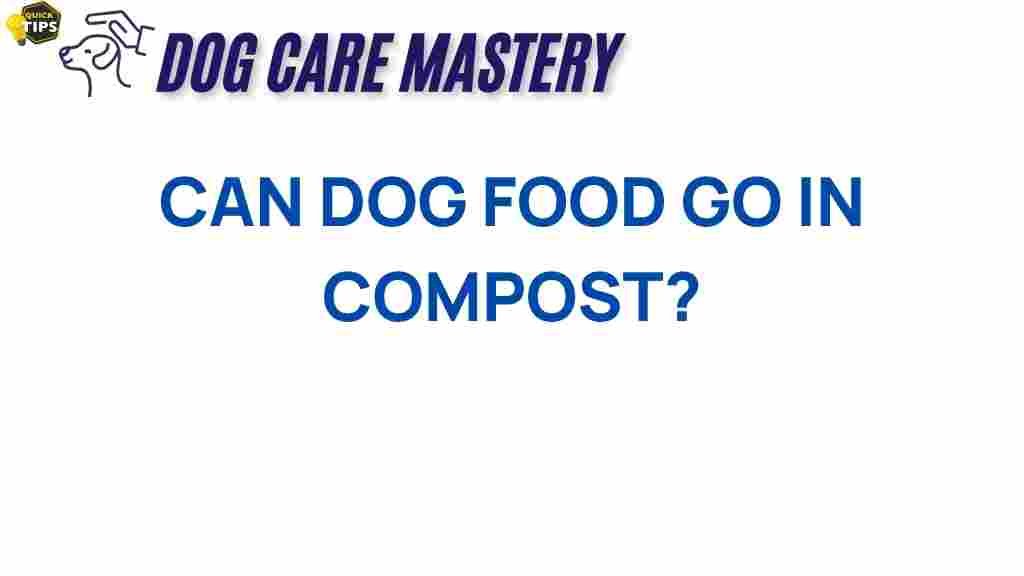Can Dog Food Go in Compost? Understanding the Role of Dog Food in Composting
When it comes to sustainable living, composting is a popular method for recycling organic waste. But what about pet waste and food? Many pet owners wonder, “Can dog food go in compost?” This question is not just about convenience; it’s about ensuring that we are composting responsibly and effectively. In this article, we will unravel the secrets of pet waste disposal, focusing specifically on how dog food interacts with composting processes.
Understanding Composting
Composting is the natural process of recycling organic matter, such as dead plants and food scraps, into a valuable fertilizer. This process involves microorganisms breaking down these materials in a controlled environment. Composting not only reduces waste but also enriches the soil, promotes plant growth, and helps combat climate change by reducing methane emissions from landfills.
The Importance of Proper Composting
Before we dive into whether dog food can be composted, it’s essential to understand the basics of composting:
- Carbon to Nitrogen Ratio: A successful compost pile requires a balance of carbon-rich materials (browns) and nitrogen-rich materials (greens).
- Aeration: Compost needs air to facilitate the decomposition process. Turning the pile regularly ensures proper aeration.
- Moisture: The compost should be moist but not soggy. Overly wet compost can lead to anaerobic conditions, which can produce foul odors.
Can Dog Food Go in Compost? The Answer You’re Looking For
The short answer is: it depends. Composting dog food is a complex issue that involves several factors, including the ingredients of the dog food and the type of composting system you use. Here’s a closer look:
Types of Dog Food
Dog food comes in various forms, including:
- Dry Dog Food: Typically made from grains, meat, and various additives.
- Canned Dog Food: Often high in moisture and includes meat by-products, grains, and preservatives.
- Raw Dog Food: Composed of uncooked meat, vegetables, and sometimes grains.
Each type of dog food has different composting implications. For instance, raw dog food may pose a higher risk of pathogens, while dry kibble may break down more readily.
Composting Dog Food: Step-by-Step Process
If you decide to compost dog food, follow these steps to do it safely and effectively:
- Choose the Right Composting Method: For dog food, a hot composting system is recommended. This method involves maintaining high temperatures (130°F to 160°F) to kill pathogens and parasites.
- Mix with Carbon-Rich Materials: Combine dog food with plenty of carbon-rich materials like dry leaves, straw, or cardboard to balance the nitrogen content.
- Aerate Your Pile: Regularly turn your compost pile to ensure proper aeration, which helps maintain high temperatures and speeds up decomposition.
- Monitor Moisture Levels: Keep the compost pile moist but not soggy. You can add water as needed, but avoid over-saturating.
- Compost Temperature: Use a compost thermometer to check the internal temperature. Ensure it stays within the recommended range to effectively kill harmful pathogens.
- Wait for Decomposition: Allow the compost to break down fully before using it in your garden. This process can take several months.
Potential Risks of Composting Dog Food
While composting dog food is possible, it does come with some risks:
- Pathogens: There is a risk of harmful bacteria, such as Salmonella or E. coli, especially with raw dog food.
- Odors: Improperly managed compost can produce unpleasant smells, attracting pests.
- Unwanted Nutrients: Some dog foods contain additives or preservatives that may not break down well and could harm your garden.
Alternative Pet Waste Disposal Methods
If you’re hesitant about composting dog food, consider these alternatives:
1. Pet Waste Digester Systems
These systems are designed to break down pet waste safely. They work similarly to a septic system and can effectively manage both dog food and waste.
2. Municipal Composting Facilities
Many municipalities have composting facilities that can handle pet waste. Check with your local waste management services to see if such options are available.
3. Biodegradable Dog Waste Bags
Using biodegradable bags can help dispose of dog food and waste responsibly. These bags break down naturally, reducing landfill impact.
Troubleshooting Tips for Composting Dog Food
If you encounter issues while composting dog food, consider these tips:
1. Smell Issues
If your compost smells foul, it may be too wet or not aerated enough. Add dry materials like leaves or straw and turn the pile more frequently.
2. Pest Problems
Pests can be attracted to the smell of dog food. Ensure you bury the dog food deep within the compost pile and maintain proper aeration.
3. Slow Decomposition
If your compost is breaking down slowly, it may lack sufficient nitrogen. Add more green materials, such as grass clippings or vegetable scraps.
Conclusion: Responsible Composting Practices for Dog Food
In conclusion, the question, “Can dog food go in compost?” has a nuanced answer. While it is possible to compost dog food, doing so requires careful consideration of the type of food, the composting method, and the potential risks involved. If you choose to compost dog food, be sure to follow the step-by-step guide provided above to minimize risks and maximize benefits.
If you’re still unsure about composting dog food or want to explore more about pet waste disposal, consider reaching out to local gardening clubs or checking resources at your local extension office. For further reading on composting techniques, visit this informative guide.
Ultimately, responsible pet ownership includes understanding how to manage pet waste and food effectively. By integrating sustainable practices into your pet care routine, you can contribute positively to the environment while ensuring your furry friend’s health and happiness.
This article is in the category Nutrition and created by dogcaremastery Team

1 thought on “Can Dog Food Go in Compost? Unraveling the Secrets of Pet Waste Disposal”